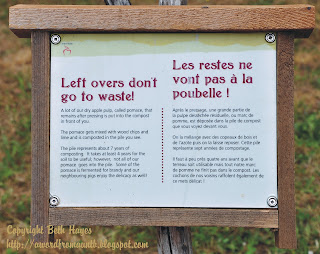Between my recent visit to Merridale Cidery and the many
pints of applesauce I’ve canned in the past couple of weeks, I’ve got apples on
my mind these days.
There are few things more evocative of autumn than a
freshly picked apple. After the lush abundance of summer’s soft fruits, the crisp
texture and slightly tart flavour of a freshly picked apple is tonic. The smell of them cooking in my kitchen is a
sure sign that summer is winding down.
Apples are so abundant and so common now that we tend to
take them for granted. Because we see
them in the store year round, we no longer appreciate them as a seasonal fruit
and, because we see just a few commercial varieties offered for sale, we’ve long
since lost our appreciation for the variety of flavours, textures, and colours apples
once brought to the table.
Apples were once a major commercial export crop in Canada
but, for decades now, production has declined annually. Canadians eat about 35 pounds of apples per person
per year but, increasingly, those apples are imported either from nearby
Washington State, from New Zealand, or from China. In 2008 Canada ranked 27th in world apple
production, and that number is likely to continue to decline.
I’m saddened that, in a place so perfectly suited to
growing apples, commercial apple orchards are on the decline. I’m sadder still
to see an ongoing loss of apple varieties.
Only 15 or so of the 7,500 known apple varieties are grown for
commercial sale.
The apple’s biology inclines it to diversity. Apples have 57,000 genes (compared with
humans’ 30,000) and are triploids, with three sets of chromosomes that cannot
be divided evenly. The potential for
variation in such an arrangement is enormous.
They’re a very adaptable crop.
In the wild, apples grow quite readily from seeds. However,
like most perennial fruits, apples are ordinarily propagated asexually by grafting. This is because
seedling apples are an example of "extreme heterozygotes", in that rather than inheriting DNA from their
parents to create a new apple with those characteristics, they are instead
different from their parents, sometimes radically.[i]
Apples are easily grafted, meaning that you can cut a
piece from one apple tree, splice it into the living stock of another apple
tree, and it will grow. This attribute
enables orchardists to graft an apple with desirable qualities that may not be
particularly hardy onto the root stock of a tree with less desirable qualities
that is more able to withstand seasonal weather conditions. It also enables orchardists to graft stock
from large trees onto root stock with a dwarf or semi-dwarf habit in order to
grow smaller, more easily managed trees. It’s even possible to graft several different varieties
of apple into a single tree.
Genetic diversity and its affinity for grafting have made
the apple an extremely versatile and important food crop for more than two
thousand years.
Apples have been cultivated for their sweet or bitter
flavours, for acidity or lack of it, for tender or very firm (or red, pink,
white, pale yellow, or pale green) flesh, for their tall or dwarf growing
habits, for their ability to be pruned into espaliers (living fences or
trellises), and for their ability to withstand specific sets of weather
conditions. They have been grown in
shapes ranging from very round to almost conical and with skins that are green,
yellow, orange, red, brown or any number of combinations of these colours. Some apples are rough. Some are smooth and shiny. Some are very large, and others are
tiny.
It used to be that a drive across country at harvest-time
would enable a person to encounter and sample many different apple varieties. It’s more difficult to do that now. Most heritage apples – not considered
commercially viable crops – survive in back yards, in small holding orchards,
or through the concerted efforts of seed savers and seed banks.
Loss of plant diversity is of concern to all of us. If we grow only a few varieties of any crop, the
crop’s survival can be threatened by inclement weather, or by diseases or pests
which spread easily through genetically similar plants. If we grow many varieties within that same
crop, the chances are much better that at least some of them will survive regardless
of any adverse conditions that may come our way.
Growing varieties that are best adapted to local
conditions rather than concerning ourselves exclusively with their commercial
properties is also kinder to the environment.
Plants well suited to their growing conditions are more amenable to organic farming
techniques, better enabling farmers to avoid the use of pesticides, fungicides, chemical fertilizers, or extra watering.
And, of course, crop diversity brings with it the joy of
being able to experience many different flavours, colours, and textures instead of limiting
ourselves to just a few.
You can support genetic diversity within our apple crops and
help to ensure the continuing survival of heritage species by seeking out and
buying heritage variety apples.
Farm markets can be a great place to find heritage
apples. In recent years we’ve found Gravenstein,
Northern Spy, Fall Russett, Cox’s Orange Pippin, Cortland, and Rome Beauty
apples at the weekend market here in Duncan.
Specialty orchards are beginning to make their mark
too. Look for heritage orchards in your
local agricultural directory. Many sell
not only apples, but also trees for planting.
Please seek out some heritage apple varieties this
fall. Enjoy your apple a day with good
conscience, and enjoy some new-to-you flavours too.
Related links:
Related links:












